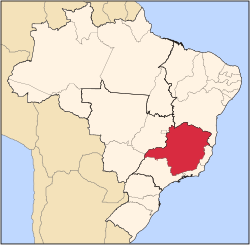History
The village of Vermelho Novo was founded in the mid-nineteenth century by the family Pinto. Its name originated due to the amount of red leaves falling on the little river giving it a reddish appearance.
Originated from this town important personalities, such as priest Manoel Moreira de Abreu, considered by its inhabitants miracle and Miguel Moreira de Abreu who written a small booklet about the history of the town.
Education
The town has two schools: one belongs to municipality "Escola Municipal Padre Manoel Moreira de Abreu", until the fourth grade, and another state to the high school, the "Escola Estadual Farmacêutico Soares".
Access to higher education takes place in the city of Caratinga with the "Centro Universitário de Caratinga" and "Faculdades Integradas de Caratinga". There are students in various courses, like Accounting Sciences, Medicine, Nursing, Social Services, Law, Civil Engineering among others. The Higher Education made very recently.
This page is based on this
Wikipedia article Text is available under the
CC BY-SA 4.0 license; additional terms may apply.
Images, videos and audio are available under their respective licenses.

